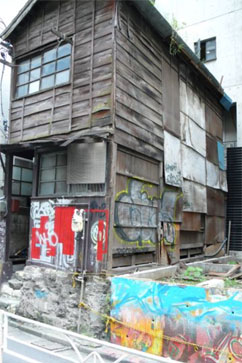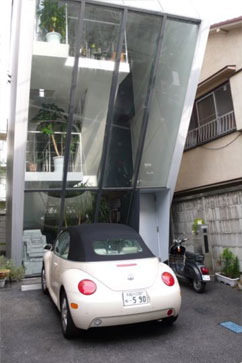 |
By Richard Seireeni |
|
|
|
by Richard Seireeni, Brand Architect August 6, 2008 |
||||
I was watching this very funny video showing six Japanese wrestlers tear down a traditional Japanese house with their bare hands. It got me thinking about all those vacant lots and empty houses I see in Tokyo and the shiny new homes replacing the newly old. For in Japan, the typical city home doesn't last long — less than 14 years on average during the Bubble Period. The Japanese government recently expressed concern about this problem that results in underutilized resources and expensive disposal problems. Yes, building new homes only to tear them down a few years later is an environmental problem. So much so that the government has passed strict recycling rules for home demolition and is contemplating changes to the previously untouchable inheritance laws that are exacerbating the problem. So, to get to the bottom of this story, I consulted with my friend and colleague, Miki Saito. Miki is a brand consultant as well as a designer of home renovations — a business that has only recently come into demand. I invited Miki for lunch. She suggested an organic café appropriately built into the ground floor of a newly renovated building in the Yoyogi Uehara area of west Tokyo. So with her new baby trying to stay cool in his stroller, Miki explained that the problem is complex. First, buildable land is in very short supply in the inner city areas where social life and amenities are so much better than in the trackless suburbs at the end of a one-hour commute. So much so that the actual home isn't worth much compared to the land. When land changes hands the building is likely to be torn down and replaced with something the new owner likes better. Also, most housing in Japanese cities is rented, so there is an incentive for landlords to keep properties new and desirable to support a premium price. The second problem is the inheritance tax, which is very high in Japan. It's not unusual for two generations to live in the same house, a phenomenon called isedaij taku. When a parent dies, the heirs often cannot afford the tax on the house they are living in, so they tear the house down so they can subdivide the property into tinier and tinier lots, maybe selling part and keeping a tiny piece for themselves. If the market isn't right for a sale, the property may be held vacant or turned into a short term parking lot. Newsweek recently reported on this phenomenon and the growing popularity of ultra-compact micro-homes, called kyo-sho-jutaku, in a country already known for small living spaces and miniaturization. The last reason is maybe more a case of keeping up with the Takahashi's. Older Japanese homes, even those built just a few years ago, tend to be cheaply built with little character and few amenities. It's probably the result of the rapid rebuilding of Japanese cities that were bombed out during the war. The stock that replaced the traditional Japanese home was built for expedience, not for beauty and durability. Today's Japanese urbanites appreciate modernity and the style that comes with it. When they have the chance, they prefer something new to something old. In many cases, it's actually been cheaper to rebuild than to repair, until recently. So I asked Miki about her remodeling business, which seemed to run counter to this trend. She explained that many young Japanese couples are marrying later and putting discretionary money into their homes. As in the US, there is a nesting trend going on. Short on cash, these young Japanese will buy a condo in an older, less desirable building. They'll hire a hot architect or interior designer to design a makeover. The apartment might be just a couple hundred square feet, but they'll do it to the nines with the latest fixtures and appliances — all in an effort to make their living space a reflection of their particular lifestyle. So instead of the Gucci shoulder bag, it's now the Gaggenau cook top — an object where luxury has retained its luster. There are entire magazines devoted to the subject, including Lives, Modern Living and I'm Home that featured one of Miki's projects. These magazines profile a range of styles from Neo Japanesque to Bali Modern. They are filled with ads for luxury appliances, marble tops, built-in cabinets, skylights, furniture, radiant heating systems — all the things to tempt someone into remodeling their crib. Unfortunately, there is very little talk about green building. Miki explained that green building hasn't caught on in the residential market, despite the fact that so much green tech is being pioneered in Japan and LOHAS has been a household word here for years. Of course, many Japanese building materials are green by virtue of efficiency and to keep cost down. Wood is almost always a veneer. Appliances are super compact and energy efficient. Most construction materials are made from recycled or reclaimed materials. There is also concern for personal health, so toxic paints and adhesives have received special scrutiny from the government for some time. But they don't have an EcoOptions section at the local home improvement center, and none of these magazine ads mentioned the green thing. So what's the bottom line? Well, the Japanese do not seem to have a McMansion problem. Quite the contrary, they are building ever smaller homes. The desire to tear down and rebuild seems to be abating, especially as the new home stock is increasingly built for the long term. Green building isn't quite the fad it is here, but the typical Japanese is consuming a fraction of the earth's resources compared to us big-shouldered Americans. © Rick Seireeni, Brand Architect and President The Brand Architect Group is a strategic brand consultancy with offices in Los Angeles, Tokyo and Shanghai. Project specialties include retail, food service, banking and real estate development.
|
The old and the new. A traditional Japanese city house, called machiya, slated for demolition and its possible replacement, a brand new ultra-compact micro-home. Articles by Richard Seireeni: |
![]()


